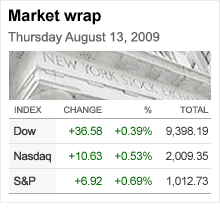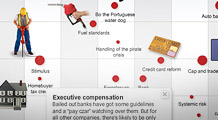Wall Street at new '09 highs
Stocks muster gains as optimism in Fed report ultimately trumps weaker retail sales and more jobless claims.

NEW YORK (CNNMoney.com) -- Stocks ended higher Thursday after a choppy session, as the Fed's economic outlook and a positive government debt auction overshadowed a report showing a surprise drop in retail sales.
The Dow Jones industrial average (INDU) added 37 points, or 0.4%, ending at its highest point since Nov. 4.
The S&P 500 (SPX) index rose 7 points, or 0.7%, ending at its highest point since Oct. 6.
The Nasdaq composite (COMP) gained 10 points, or 0.5%, ending at its highest point since Oct. 1.
Wal-Mart (WMT, Fortune 500)'s better-than-expected earnings report and a spike in financial shares also helped support stocks.
Financial shares added to the gains. Bank of America (BAC, Fortune 500), Citigroup (C, Fortune 500), and Wells Fargo (WFC, Fortune 500) all rose along with regional banks such as Fifth Third Bancorp (FITB, Fortune 500) and Regions Financial (RF, Fortune 500). The KBW Bank (BKX) index gained 3.1%.
Thursday's jump followed a rally Wednesday after the Federal Reserve held interest rates near historic lows and signaled the economy has finally started to stabilize.
Earlier this week, stocks had stalled out as the major gauges struggled to remain above key psychological levels -- 2,000 for the Nasdaq and 1,000 for the S&P 500. But shares managed to close decidedly above those levels Thursday.
In bonds, the last of the government's three debt auctions this week -- this time $15 billion in 30-year bonds -- saw strong demand, helping to support the market.
Economy: Indications that the global economy could be stabilizing provided investors with some optimism, but that was countered by Thursday's weak readings on consumers.
On Thursday, both France and Germany posted GDP growth in the second quarter, surprising economists.
In the United States, the Federal Reserve provided a little optimism Wednesday, saying that although economic activity is likely to remain weak, the decline is leveling out and financial market conditions appear to have improved. This seemed to echo recent reports showing the economy is stabilizing.
"We're starting to see an improvement and we could see a quarter or so of higher growth on recovering inventories," said Stephen Mahoney, fixed income portfolio manager at Glenmede Investment Management.
"But the question is where do we go from here?," he said. "We need to see a few quarters of strong growth, not just one quarter."
Future growth could be constrained by consumers, who continue to beef up their savings and avoid spending on non-essentials, as Thursday's retail sales and jobless claims reports made clear.
The Commerce Department reported Thursday that business inventories declined for the 10th straight month.
Friday brings reports on consumer sentiment, industrial production and capacity utilization -- and consumer prices.
The Consumer Price Index (CPI) for July is expected to come in unchanged, as inflationary pressure remains benign. CPI rose 0.7% in June. The so-called Core CPI, which strips out volatile food and energy prices, is expected to have risen 0.1% after rising 0.2% in June. The Labor Department releases the report.
Retail sales slip: Retail sales fell 0.1% in July, the Commerce Department reported Thursday. The results were a surprise to economists who were looking for a rise of 0.7%, on average, according to a Briefing.com survey. Sales rose 0.8% in June.
Results would have been worse if not for the government's Cash for Clunkers program, which boosted auto sales. Retail sales excluding autos fell 0.6% in July versus forecasts for a rise of 0.1%. Sales without autos rose a revised 0.5% in June.
The report is worrisome, as consumer spending fuels two-thirds of gross domestic product growth. So far, low prices and government stimulus have helped the economy stabilize, but without a pickup in spending, any recovery will be moderate at best.
In related news, Ford Motor (F, Fortune 500) said it is boosting production for the rest of the year to meet increased demand as a result of Cash for Clunkers.
Wal-Mart Stores: The No. 1 retailer reported quarterly earnings Thursday.
On the upside, Wal-Mart earned 88 cents per share versus 87 cents a year ago and more than what analysts surveyed by Thomson Reuters expected. Wal-Mart also said that it expects current-quarter earnings in line with analysts' forecasts.
But revenue fell more than expected and the company said customers were cutting back. The Dow component also said that sales at stores open a year or more, also known as same-store sales, fell 1.2% in the quarter.
Nonetheless, investors focused on the positive and shares gained 2.7% Thursday.
Labor market: The number of Americans filing new claims for unemployment rose to 558,000 last week, surprising economists who were expecting jobless claims to drop to 545,000 claims.
However, the Labor Department report also showed that continuing claims, which measures people who have been receiving benefits for a week or more, fell to 6,202,000 from 6,343,000 in the previous week.
Housing: The housing market remains constrained, according to a new report released Thursday. Foreclosure filings jumped almost 7% in July from the previous month, according to RealtyTrac. Filings rose 32% from a year ago.
Bonds: Treasury prices gained, lowering the yield on the benchmark 10-year note to 3.59% from 3.71% Wednesday. Treasury prices and yields move in opposite directions.
The government is auctioning $75 billion in debt this week as part of its efforts to reduce the deficit and fuel its recovery efforts.
On Thursday, Treasury auctioned $15 billion in 30-year bonds to strong demand.
The first two auctions had mixed results. Tuesday's sale of $37 billion in three-year notes saw stronger demand than other recent auctions. Wednesday's auction of $23 billion in 10-year notes showed demand roughly in line with recent levels.
Oil and gold: U.S. light crude oil for September delivery rose 36 cents to settle at $70.52 a barrel on the New York Mercantile Exchange.
COMEX gold for December delivery rose $4 to settle at $956.50 an ounce.
Other markets: In global trading, European markets ended higher, while Asian markets ended lower.
In currency trading, the dollar fell versus the euro and the Japanese yen.
Market breadth was positive and trading volume was moderate. On the New York Stock Exchange, winners topped losers two to one on volume of 776 million shares. It was the second slowest trading day of the year for the NYSE, eclipsed only by the day before the July 4th holiday.
On the Nasdaq, advancers beat decliners seven to six on volume of 2.11 billion shares. ![]()



